Diversity of plants and animals
- Books Name
- Science Made Easy Science Book
- Publication
- Science Made Easy
- Course
- CBSE Class 9
- Subject
- Science
Introduction
→ All living organism are grouped on the basis of their similarities and increasing complexities into different complexities.
→ Biodiversity means the variety of living organisms present on a particular region.
→ There are about 20 lac organisms known on the earth which differ from one another in externaform, internal structure, mode of nutrition, habitat, etc.
• Taxonomy:
It is a branch of biology which deals with identification, nomenclature andclassification of organisms.
Carolus Lannaeus is called the father of taxonomy.
basic issues in scientific naming, basis of classification
- Books Name
- Science Made Easy Science Book
- Publication
- Science Made Easy
- Course
- CBSE Class 9
- Subject
- Science
Classification
→ The method of arranging organisms into groups or sets on the basis of similarities anddifferences is called classification.
→ It makes the study of wide variety of organisms easy and in systematic manner.
→ It helps to understand how the different organisms have evolved with
time.
→ It helps to understand the inter-relationships among different groups of organisms.
→ It forms a base for the study of other biological sciences, like biogeography.
Basis of Classification
→ There are certain features or properties used for the classification of living organisms which areknown as characteristics.
→ Organisms with same characteristics are placed in same groups.
Classification System
• Two kingdom classification:
Carolus Linnaeus in 1758 classified the living organisms into twogroups as plants and animals.
• Five kingdom classification:
H. Whittaker in 1959 further classified the organisms into fivekingdoms as Kingdom Monera, Kingdom Protista, Kingdom Fungi, Kingdom Plantae and Kingdom Animalia.
→ Carl Woese in 1977 further divided Kingdom Monera into archaebacteria (or Archae) andEubacteria (or Bacteria).
Hierarchy of categories / groups
- Books Name
- Science Made Easy Science Book
- Publication
- Science Made Easy
- Course
- CBSE Class 9
- Subject
- Science
• Hierarchy of Classification:
Linnaeus proposed a classification system by arranging organismsinto taxonomic groups at different levels according to the characteristics they have.
Groups or Levels from top to bottom
→ The major characteristics considered for classifying all organisms into five major kingdoms.
• Type of cellular organization
(i) Prokaryotic cells: These are primitive and incomplete cells without well defined nucleus.
(ii) Eukaryotic cells: These are advanced and complete cells with well-defined nucleus.
• Body organization
(i) Unicellular organisms: These are organisms made up of single cell with all activities performed the single cell.
(ii) Multicellular organisms: These are organisms made up of large number of cells with differentfunctions performed by different cells.
• Mode of obtaining food
(i) Autotrophs: These are the organisms that make their own food by photosynthesis.
(ii) Heterotrophs: These are the organisms which depend on other organisms for food.
Five Kingdom Classification
R. H. Whittaker taxonomist was the first one to propose five kingdom classification.
Monera
(i) Type: Unicellular Prokaryotic
(ii) Mode of nutrition: Autotrophic or heterotrophic
(iii) Body: Lack well-defined nucleus and cell organelles
(iv) Examples: Bacteria, Blue-green algae
Protista
(i) Type: Unicellular Eukaryotic
(ii) Mode of nutrition: Autotrophic or Heterotrophic
(iii) Body: Some organisms use pseudopodia or cilia or flagella for movement
(iv) Examples: Amoeba, Paramecium, Euglena
Fungi
(i) Type: Multicellular Non-green Eukaryotic
(ii) Mode of nutrition: Saprophytic or Parasitic Sometimes symbiotic
(iii) Body: Fungus is made up of long filaments called hyphae. The network of hyphae is mycelium.
(iv) Examples: Yeast, Rhiozpus, Mushrooms moulds
Plantae
(i) Type: Multicellular Eukaryotic
(ii) Mode of nutrition: Autotrophic
(iii) Body: Exhibits high level of tissue differentiation and have specialized body organs.
(iv) Examples: Trees, Plants, Shrubs
Animalia
(i) Type: Multicellular Eukaryotic
(ii) Mode of nutrition: Heterotrophic
(iii) Body: Exhibits high level of tissue differentiation and have specialized body organs. They havewell developed nervous system.
(iv) Examples: Fish, Insects, Animals, Humans, Birds
Kingdom I: Monera
(i) Prokaryotic, unicellular.
(ii) Can be autotrophs or heterotrophs.
(iii) May or may not have cell wall.
(iv) Examples: Anabaena and Bacteria (heterotrophic), Cyano-bacteria or Blue-green algae(autotrophic).
Kingdom II: Protista
(i) Eukaryotic, unicellular.
(ii) Can be autotrophic or heterotrophic.
(iii) May have cilia, flagella or pseudophodia for locomotion.
(iv) Examples: Plants like unicellular algae, diatoms; animals like protozoans (Amoeba, Paramecium,Euglena); fungi like slime molds and water molds.
Kingdom III: Fungi
(i) Eukaryotic.
(ii) Mostly multicellular but sometimes unicellular (yeast).
(iii) Source of food:
• Mostly saprophytes:
These organisms use decaying material for food.
• Some parasitic:
These organisms live inside body of other living organism to have food and canbe disease causing.
• Symbiotic relation:
These are relations between two organisms in which they live together forbenefit of one or both.
→ Lichens are a symbiotic relation between fungi and cyanobacteria.
→ Here fungi gets food from cyanobacteria and in return cyanobacteria gets water and protectiofrom sunlight through fungi.
(iv) Cell wall is made of chitin.
(v) Examples: Mushrooms (Agaricus), green mold (Penicillium), smut (Aspergilus).
Kingdom IV: Plantae
(i) Eukaryotic, multicellular.
(ii) Autotrophs.
(iii) Cell wall present.
Major groups of plants (salient features) (Bacteria, Thalophyta, Bryo phyta, Pteridophyta, gymnosperms and Angiosperms).
- Books Name
- Science Made Easy Science Book
- Publication
- Science Made Easy
- Course
- CBSE Class 9
- Subject
- Science
Basis of division in Kingdom Plantae
(i) Differentiated body parts:
Body is differentiated into leaves, stems, roots, flowers, etc.
(ii) Presence of vascular tissue:
There are two types of vascular tissues present in the plants.
• Xylem: Helps in transport of water.
• Phloem: Helps in transport of food.
(iii) Reproduction through seeds or spores:
• Phanerogamae : Plants with seeds are called phanerogamae. They contains embryo with stored food and are multicellular.
• Cryotogamae: Plants with spores are called cryptogamae. They contains only naked embryo and are generally unicellular.
(iv) Seeds are inside the fruit or naked:
• Angiospermae: These are plants with seeds inside the fruit and bears flowers.
• Gymnospermae: These are plants with naked seeds and do not bear flowers.
Division 1: Thallophyta
(i) Basic and elementary plants with undifferentiated body parts.
(ii) Generally called algae.
(iii) No vascular tissue present.
(iv) Reproduce through spores.
(v) Mainly found in water.
(vi) Example: Ulva, Spirogyra, Ulothrix, Cladophora, Chara.
Division 2: Bryophyte
(i) Body structure differentiated but not fully developed.
(ii) No vascular tissues present.
(iii) Reproduce through spores.
(iv) Found on both land and water therefore known as ‘ Amphibians of Plantae Kingdom’.
(v) Example : Liverwort (Marchantia, Riccia), Mosses (Funaria), Hornwort (Dendrocerous).
Division 3: Pteridophyta
(i) Differentiated body structure – leaves, stems, roots, etc.
(ii) Vascular tissues present.
(iii) Reproduce through spores.
(iv) Examples : Marsilea, fern, horsetails.
Division 4: Gymnosperms
(i) Differentiated body parts.
(ii) Vascular tissues.
(iii) Naked seeds without fruits or flowers.
(iv) Perennial, evergreen and woody.
(v) Examples : Pines (deodar), Cycus, Ginkgo.
Division 5: Angiosperms
(i) Also known as flower-bearing plants.
(ii) Later on flower becomes fruit.
(iii) Seeds are inside the fruit.
(iv) Embryos in seeds have structure called cotyledons. They are also called seed leaves becausemany plants they emerge and become green when they germinate.
Angiosperms are further divided on the basis of number of cotyledons into two parts i.e. Monocotsand Dicots.
Major groups of animals (salient features) (Non-chordates upto phyla and chordates upto classes).
- Books Name
- Science Made Easy Science Book
- Publication
- Science Made Easy
- Course
- CBSE Class 9
- Subject
- Science
Kingdom V: Animalia
Basis of classification of Animalia kingdom:
• Symmetry
(i) Bilateral symmetry:
It is when an organism can be divided into right and left halves, identical bumirror images, by a single vertical plane.
(ii) Radial symmetry:
It is when an organism is equally spaced around a central point, like spokes oa bicycle wheel.
• Germ layers
→ In embryonic stages there are different layers of cells called germ cells.
• The three different types of germ cells are:
(i) Ectoderm:
It is the outermost layer which forms nail, hair, epidermis, etc.
(ii) Endoderm:
It is the innermost layer which forms stomach, colon, urinary, bladder, etc.
(iii) Mesoderm:
It is the middle layer between ectoderm and endoderm which forms bones,cartilage, etc.
• According to the number of germ layers present in embryonic stage, animal could be:
(i) Diploblastic:
Organisms which are derived from two embryonic germ layers (ecto and endo).
(ii) Triploblastic:
Organisms which are derived from all the three embryonic germ layers.
• Coelom
→ Body cavity or coelom is important for proper functioning of various organs.
→ For example, heart which has to contract and expand needs some cavity or empty space, which is provided by the coelom.
• On the basis of presence or absence of coelom, organisms are divided into:
(i) Acoelomates: These are the simple organisms having no body cavity.
(ii) Coelomates:
These are complex organisms having true cavity lined by mesoderm from all side
→ These are further sub-divided into schizocoelomates or protostomes (coelom formed due to splitting or mesoderm) and enterocoelomates or dueterostomes (coelom formed from pouchespinched off from endoderm).
(iii) Pseudo coelamate:
These are organisms having false coelom. They have pouches of mesoder scattered between endoderm and ectoderm.
• Notochord
→ It is a long rod like structure, which runs along the body between nervous tissues and gut and provides place muscle to attach for ease of movement.
→ Organisms could be:
• without notochord
• with notochord
• with notochord in initial embryonic stages and vertebral column in adult phase.
Phylum 1: Porifera or Sponges
(i) Cellular level of organization
(ii) Non-motile animals
(iii) Holes on body which led to a canal system for circulation of water and food
(iv) Hard outside layer called as skeletons
(v) Examples: Sycon, spongilla, euplectelia
Phylum 2: Coelenterata
(i) Tissue level of organization
(ii) No coelom
(iii) Radial symmetry, diploblastic
(iv) Hollow gut
(v) Can move from one place to another
(vi) Examples: Hydra, sea anemone, jelly fish (solitary), corals (colonies)
Phylum 3: Platyhelminthes
(i) Also called flat worms
(ii) No coelom present
(iii) Bilateral symmetry, triploblastic
(iv) Free living or parasite
(v) Digestive cavity has one opening for both ingestion and egestion
(vi) Examples: Planaria (free living), liver fluke (parasitic)
Phylum 4: Mollusca
(i) Coelom present
(ii) Triploblastic, bilateral symmetry
(iii) Soft bodies sometimes covered with shell
(iv) Generally not segmented
(v) No appendages present
(vi) Muscular foot for movement
(vii) Shell is present
(viii) Kidney like organ for excretion
(ix) Examples: Chiton, octopus, pila, unio
Phylum 5: Annelida
(i) Second largest phylum
(ii) Coelom present
(iii) Bilateral, triploblastic
(iv) Segmented (segments specialized for different functions)
(v) Water or land
(vi) Extensive organ differentiation
(vii) Examples: Earthworm, leech, nereis
Phylum 6: Arthropoda
(i) Largest phylum (consist of 80% of species)
(ii) Generally known as insects
(iii) Coelom present
(iv) Bilateral, triploblastic
(v) Segmented, sometimes fused
(vi) Tough exo-skeleton of chitin
(vii) Joing appendages like feet, antenna
(viii) Examples : Prawn, scorpio, cockroach, housefly, butterfly, spider
Phylum 7: Echinodermata
(i) Spiny skin, marine
(ii) No notochord
(iii) Coelom present, bilateral symmetry, triploblastic
(iv) Endoskeleton of calcium carbonate
(v) Water vascular system for locomotion
(vi) Bilateral symmetry before birth and radial symmetry after birth
(vii) Examples : Antedon, sea cucumber, star fish, echinus
Phylum 8: Protochordata
(i) Marine animals.
(ii) Bilaterally symmetrical, triploblastic and have a coelom.
(iii) Gills present at some phase of life
(iv) Notochord is present which is a long rod-like support structure (chord=string) that runs along back of the animal separating the nervous tissue from the gut.
(v) Notochord provides a place for muscles to attach for ease of movement.
(vi) Examples : Balanoglossus, Herdmania and Amphioxus
Phylum 9: Nematoda
(i) Bilaterally symmetrical and triploblastic.
(ii) Body is cylindrical rather than flattened.
(iii) Tissues, but no real organs.
(iv) Sort of body cavity or a pseudocoelom, is present.
(v) Familiar as parasitic worms causing diseases.
(vi) Worms causing elephantiasis (filarial worms) or the worms in the intestines (roundworm orpinworms).
(vii) Examples: Ascaris, Wuchereria
Phylum 10: Vertebrata
(i) Notochord converted to vertebral column
(ii) 2, 3, 4 chambered heart
(iii) Organs like kidney for excretion
(iv) Pair appendages
(v) Examples: Humans (4-chambered), frog (3-chambered), fishes (2-chambered)
→ Vertebrates are divided into five classes namely Pisces, Amphibia, Reptilia, Aves and Mammalia
• Warm blooded organisms:
These are organisms which maintain same body temperatureirrespective of outside temperature.
Example: Humans. Human’s body temperature is approximately 37º.
• Cold blooded organisms:
These are organisms which change their body temperature as persurrounding temperature.
Example : Frog.
Pisces (Fishes)
→ They are fishes living in water.
→ Their skin is covered with scales or plates.
→ They respire using gills.
→ They have streamlined body and fins which help them to move in water.
→ They are cold blooded and their heart has only two chambers.
→ They lay eggs from which the young ones hatch out.
• Fishes are divided into two categories on the basis of skeleton:
(i) Fishes with cartilage skeleton called cartilaginous fishes. Example : Shark, Rays etc.
(ii) Fishes with bony skeleton called bony fishes. Example : Tuna, Rohu etc.
Amphibia (Amphibians)
→ They are found in land and water.
→ They do not have scales but have mucous glands on their skin.
→ They are cold blooded and the heart is three chambered.
→ Respiration is through gills or lungs. They lay eggs in water.
Example: Frogs, Toads, Salamanders etc.
Reptilia (Reptiles)
→ They have scales and breathe through lungs.
→ They are cold blooded.
→ Most of them have three chambered heart but crocodiles have four chambered heart.
→ They lay eggs with hard covering in water.
→ Example: Snakes, Turtles, Lizards, Crocodiles etc.
Aves (Birds)
→ They are warm blooded animals.
→ They have four chambered heart.
→ They breathe through lungs.
→ They have an outer covering of feathers.
→ Their two fore limbs are modified into wings for flying. They lay eggs.
→ Example: Crow, Sparrow, Pigeon, Duck, Stork, Ostrich etc.
Mammalia (Mammals)
→ They are warm blooded animals.
→ They have four chambered heart.
→ They have mammary glands for production of milk to nourish their young ones.
→ The skin has hairs and sweat glands. Most of them give birth to their young ones.
→ Some of them lay eggs (like Platypus and Echidna).
→ Example: Cat, Rat, Dog, Lion, Tiger, Whale, Bat, Humans etc.
Nomenclature
→ An organism can have different names in different languages. This creates confusion in naming
organism.
→ A scientific name is needed which is same in all languages.
→ Binomial nomenclature system given by Carolus Linnaeus is used naming different organisms.
Some conventions in writing the scientific names:
(i) Genus should be written followed by the species.
(ii) First letter of the genus should be capital and that of the species should be in small letter.
(iii) When printed the name should be written in italics and when written with hands genus and
species should underlined separately.
Example : Homo sapiens for humans, Panthera tigris for tiger.
1. Introduction-Biodiversity
Diversity in Living Organisms
Introduction
- We all know that there are abundant of living organisms present on the earth. Many organisms are not identical to each other.
- This variety of living beings present on the earth is called as a Biodiversity.
- Here is a separate branch of Biology called Taxonomy which identifies, names and classifies different organisms present on the earth.
- Carolus Linnaeus is known as the Father of the Modern Taxonomy.
- Binomial nomenclature is the naming of organisms with two names- genus and species.
- It was first established by Carl Linnaeus and later adopted by all scientists for the universal naming of organisms.
- The Law of priority is established if the same name is shared by two different species or two different taxa.
- Taxonomy deals with the identification, nomenclature, and classification of organisms.
2. Classification System
Classification of Living Things
• Classification presented by Aristotle – He classified animals on the basis of their habitats – land, water and air.
• But it can be easily observed that the animals that live at a particular habitat say land are still so different from each other.
• Therefore, it was decided to classify the living organisms on the basis of a hierarchy.
• This hierarchical classification was based on the similarities and dissimilarities in the characteristics of the living organisms.
• Organisms having similar characteristics were placed in a similar category.
Why do we need to classify organisms?
1. If we classify organisms into several categories, it will be easier for us to study them.
2. It will help us in understanding how did these organisms evolve.
3. We can also understand how different organisms are related to each other.
4. We can learn why different organisms are found at distinct geographical conditions.
Hierarchy Classification - Formation of Kingdoms
Biologists categorized different organisms into several kingdoms.
|
Classification |
Proposed by |
Type of organisms |
|
|
Two kingdom classification |
Carolus Linnaeus in 1758 |
1. Plants |
|
|
2. Animals |
|||
|
Five Kingdom classification |
Robert Whittaker in 1959 |
1. Monera |
|
|
2. Protista |
|||
|
3. Fungi |
|||
|
4. Plantae |
|||
|
5. Animalia |
|||
|
Carl Woese in 1977 |
1. Monera |
||
|
(i) Archaea |
|||
|
(ii) Eubacteria |
|||
|
2. Protista |
|||
|
3. Fungi |
|||
|
4. Plantae |
|||
|
5. Animalia |
|||
|
|
|
|
|
The order of Classification
1. Kingdom
2. Phylum / Division
3. Class
4. Order
5. Family
6. Genus
7. Species
Species is called as the Basic Unit of Classification. Species is a group of organism which can interbreed with each other. The picture below explains how humans are classified in a hierarchical order.
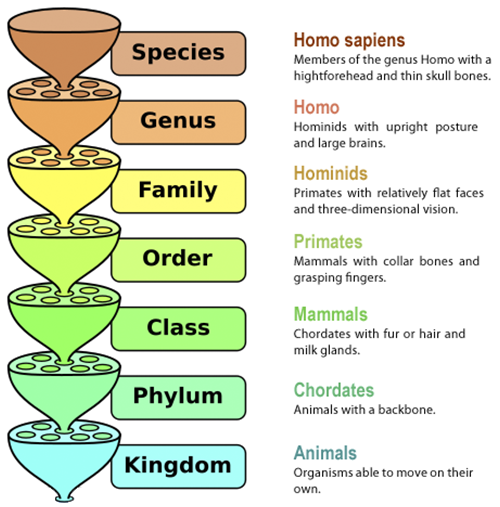
Hierarchical Order of Classifying Humans
Five Kingdom Classifications
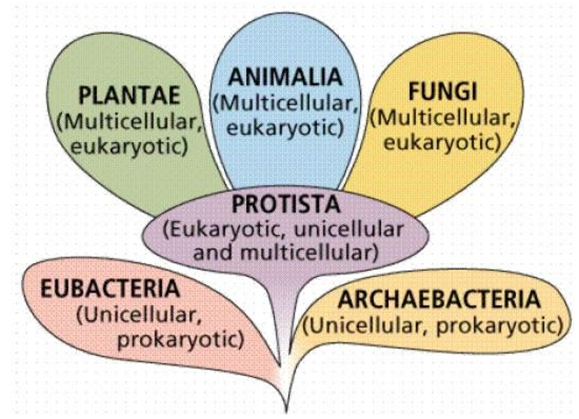
Five Kingdom Classification
- The organization inside the cells
-
- Prokaryotic Cells – Cells with no definite nucleus
- Eukaryotic Cells – Cells with a definite nucleus
- The organization of cells in the body
-
- Unicellular – Single-celled organisms
- Multicellular – Multi-cell organisms
- organisms obtain their food
-
- Autotrophs – Produce their food on their own
- Heterotrophs – Depend on other organisms for their food
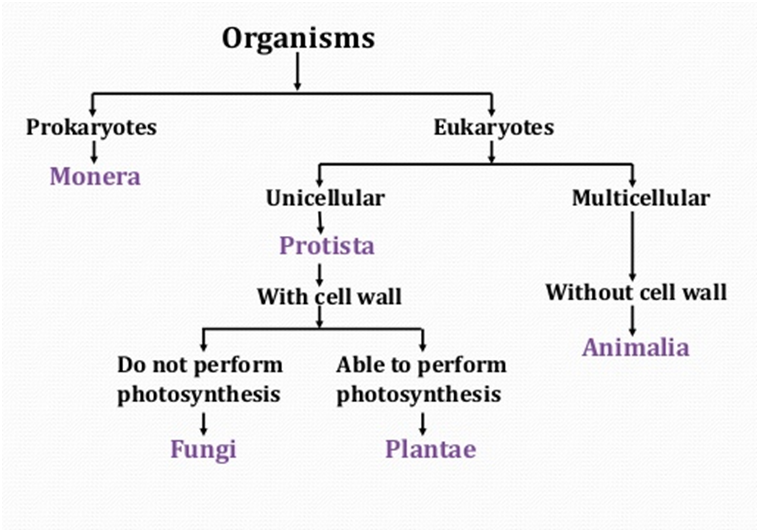
Classification of Organisms
Classification of Organisms
|
|
Monera |
Protista |
Fungi |
Plantae |
Animalia |
|
Organization inside the cells |
Consists of Prokaryotes. |
Eukaryotes – some of them use appendages to move around such as flagella (whip-like structure) and Cilia (hair-like structure) |
Eukaryotes |
Eukaryotes |
Eukaryotes |
|
Organization of cells in the body |
Unicellular |
Unicellular |
Initially unicellular. Can become multicellular in later stages of life |
Multicellular |
Multicellular |
|
Organisms obtain their food |
Some of them are autotrophs like blue green algae while others are heterotrophs |
Both autotrophs and heterotrophs |
Heterotrophs. Most of them are decomposers or may be parasitic. |
Autotrophs |
Heterotrophs |
|
Presence of cell wall |
Some lack a cell wall while others have a cell wall |
Only some have cell wall |
Have cell walls. They are made up of complex sugar called chitin. |
Have cell walls made of cellulose. |
No cell walls |
|
Example |
Blue-green algae, Bacteria, Mycoplasma |
Protozoan, Diatoms and Golden algae |
Yeast and Mushroom ( Agaricus), Rhizopus ( Bread mould), Pencillium |
Flowering plants, moss |
Insects, reptiles |
Archea Kingdom
The monera kingdom is further classified as Archaea.
These are microbes (bacteria) that can live in harsh conditions. Since they can live in extreme temperatures, they are also called Extremophiles.
These organisms lack a cell wall.
Their cell membrane is made up of lipids.
They are further classified into three categories, based on their habitat:
|
Halophiles |
Thermophiles |
Methanogens |
|
These are salt loving bacteria. They live in extremely salty water. |
They live in boiling water such as hot springs and volcanoes. |
They are found in the guts of animals like cow and sheep. They produce methane gas from their dung. |
Who are Saprophytes?
Fungi also called as Saprophytes because they grow over the organic material and survive on them.
What are Symbiotic relationships?
Some species of fungi live in permanent mutually dependent relations with blue-green algae. They are said to have a symbiotic relationship. For Example, Lichens are often found on the bark of the trees.
3. Plant Kingdom
Kingdom Plantae
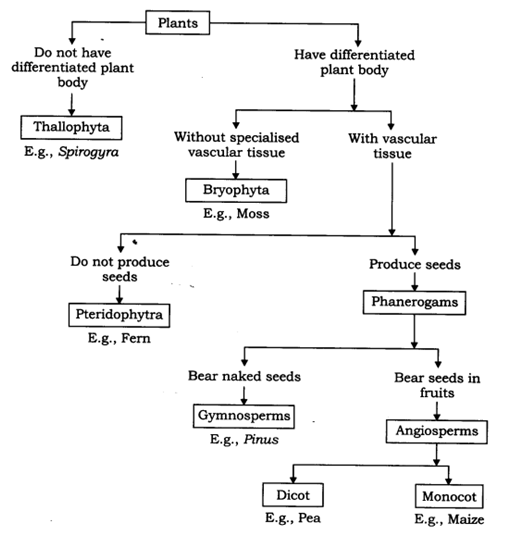
Plant Kingdom
• Components of Plants – whether they are distinct or not
• Presence of Special Tissues in plants for the transportation of food and water
• Presence of Seeds – whether the seeds are present inside the fruits or not.
Classification of plants on the ability to produce seeds -
• Cryptogams – These plants do not have well developed reproductive organs. The organs cannot be seen clearly as well and appear as if they are hidden. Example are Thallophyte, Bryophyta and Pteridophyte.
• Phanerogams – These plants have well developed reproductive organs hence they can produce seeds. They are further classified as the ones which have seeds hidden inside fruits or not - Gymnosperms and Angiosperms
|
Criteria |
Thallophyta |
Bryophyta |
Pteridophyta |
|
Components of plants |
No distinct components. Undifferentiated Body |
Little differentiated body. Distinct components are present as leaves and stem |
Distinct components are present as roots, leaves and stem |
|
Presence of special tissues- Vascular tissue |
No |
No |
Yes |
|
Presence of seeds |
No |
No |
No |
|
Found in |
Aquatic environment, snow |
First terrestrial plants but but need water for sexual reproduction. So called as Amphibian of plant kingdom. |
Terrestrial or dry areas |
|
Example |
Spirogyra, Ulothrix, Volvox |
Moss and liverworts |
Ferns |
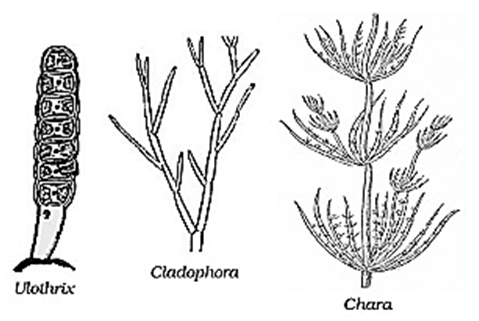
|
|
Gymnosperms |
Angiosperms |
|
The ability to produce seeds |
Naked seeds |
Seeds develop in an organ which then turns into the fruit |
|
Existence |
Exist for long time periods, Evergreen |
Grow for varied time periods |
|
Type |
Woody, No flowers |
Flowering plants |
|
Meaning |
Gymno – naked |
Angio – Covered |
|
Sperm – seeds |
Sperma – seeds |
|
|
Example |
Pines, Deodar |
Mustard, Maize |
What are Cotyledons?
The seed leaves in Angiosperms are called Cotyledons. They turn green on the germination of the seeds. Angiosperms can be divided into two types on the basis of the presence of cotyledons in them-
- Monocotyledons or monocots
- Dicotyledons or Dicots
|
Criteria |
Monocotyledons or Monocots |
Dicotyledons or Dicots |
|
Cotyledons (Seed Leaves) |
Single Cotyledon |
Two Cotyledons |
|
Leaves |
Long leaves, with parallel veins |
Broad leaves with network of veins |
|
Roots |
Fibrous |
Long taproot |
|
Floral Parts |
Multiples of three |
Multiples of four or five |
|
Example |
Corn, Wheat, Grass |
Rose, Sunflower, Lily |
4. Animal Kingdom
Kingdom Animalia
Basic Characteristics of the Animalia Kingdom
1. Animals are eukaryotic, multicellular organisms that lack a cell wall.
2. They are heterotrophs therefore they rely on others for food.
3. They have a growth pattern. The adult animals have a specific shape and size.
4. Most of the organisms have well-defined organ systems such as Respiratory System, Digestion System and so on.
5. Most of the animals can move. They aren’t stationary as Plants.
6. Animals have a nervous system which is why they are able to respond to an external stimulus.
Animals are classified on the basis of differences in their body type and design. The body cavity or coelom in animals contains the organs. Based on the presence of body cavity animals can be categorized as:
1. Coelomate – They have true body cavity called Coelom
2. Pseudocoelomate – It means false cavity. They have a body cavity which is filled with fluid
3. Acoelomate – They have no body cavity at all.
1. Phylum - Porifera
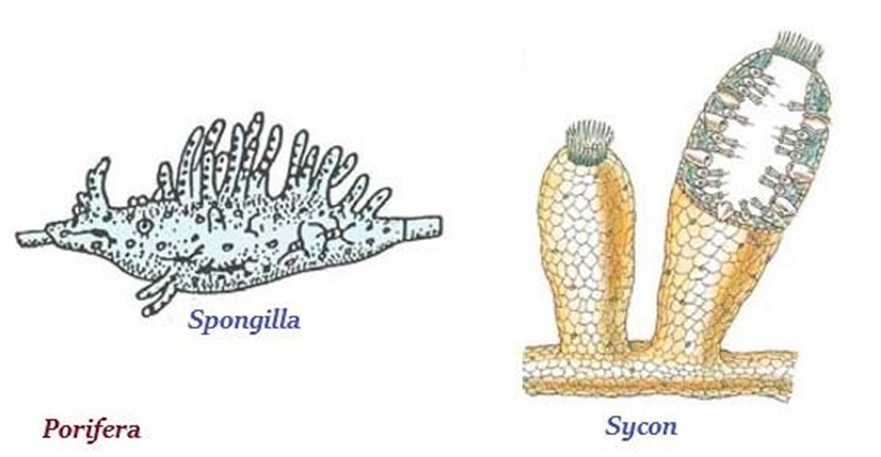
Phylum- Porifera
• Level of Organization – Cells are present
• Symmetry – Asymmetrical
• Segmentation – No segments
• Body Cavity/ Coelom – No
• Presence of Organs – No
• Examples – Sycon, Spongilla, Euspongia
• Other Characteristics-
o They cannot move and are attached to a support.
o They have pores in their body
o These pores form a Canal system through which water and food circulate in the body and waste is removed.
o They have a skeleton made of spongin protein and calcium carbonate – hard covering on them
2.Phylum - Coelentrata
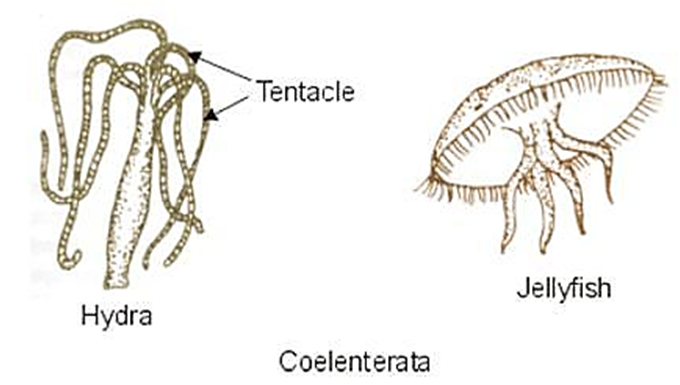
Phylum- Coelenterata
• Level of Organization – Tissues, Cells have two layers – so called as Diploblastic Organism
• Symmetry – Radial
• Segmentation – No segments
• Body Cavity/ Coelom – No
• Presence of Organs – No
• Examples – Aurelia (Jelly fish) and Adamsia (Sea Anemone)
• Other Characteristics –
o Some of them live in colonies - They are physically attached to each other such as Corals
o Some of them live solitary such as Hydra
3.Phylum - Platyhelminthes
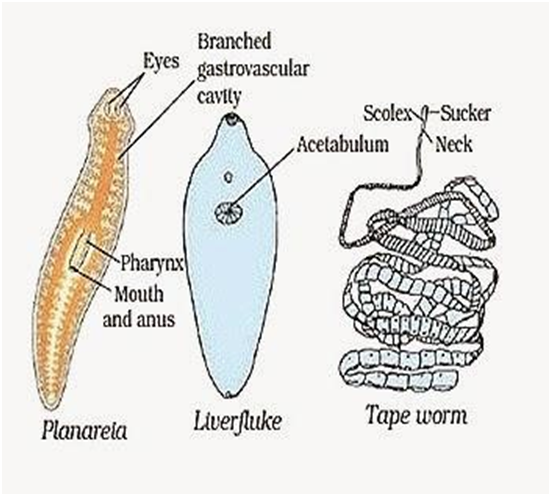
Phylum Platyhelminthes
• Level of Organization – Organs, The cells have three layers – so are called Triploblastic
• Symmetry – Bilaterally Symmetrical - Left half of the body is identical to the right half
• Segmentation – No segments
• Body Cavity/ Coelom – No so called as Acoelomates
• Presence of Organs – Yes
• Examples – Taenia solium (Tapeworm), Fasciola hepatica (Liver Fluke)
• Other Characteristics -
o They have a flat body and thus are called Flatworms
o They can be Free-living like Planaria or parasitic.
4. Phylum- Nematode
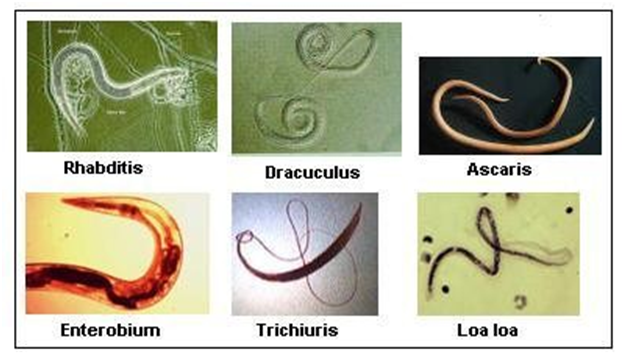
Phylum Nematoda
• Level of Organization – Tissues so are called Triploblastic
• Symmetry – Bilaterally Symmetrical - Left half of the body is identical to the right half
• Segmentation – No segments
• Body Cavity/ Coelom - False body cavity so called as Pseudocoelomates
• Presence of Organs – Organ System Level Organisation
• Examples – Parasitic worms and worms in the intestine
• Other Characteristics–
o They are called as Round Worms.
o Sexual dimorphism visible - Female and male worms are distinct.
- 5. Phylum Annelida
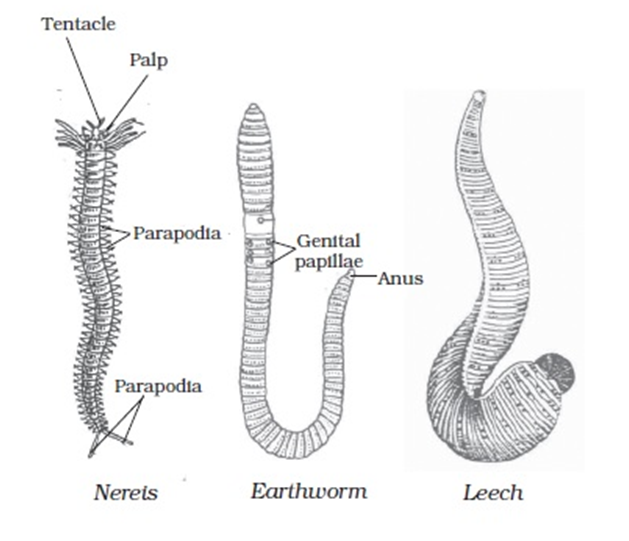
Phylum Annelida
• Level of Organization – Organ system level, the cells have three layers so called Triploblastic
• Symmetry – Bilaterally Symmetrical
• True Segmentation – Present (organs can be identified separately)
• Body Cavity/ Coelom – True body cavity so called as Coelomates
• Presence of Organs – Definite organs
• Examples – Leech, Earthworms
• Other Characteristics –
o They are found in freshwater and marine water.
o They have closed Circulatory system.
6. Phylum Arthropoda

Phylum Arthropoda
• Level of Organization – Organ systems
• Symmetry – Bilaterally symmetrical
• Segmentation – Present (organs can be identified separately)
• Body Cavity/ Coelom – True body cavity
• Presence of Organs – Definite organs
• Examples – Prawns and butterflies
• Other Characteristics
o They have jointed legs
o They have an open circulatory system – There are no well-defined blood vessels
o They have chitinous exoskeleton
7. Phylum - Mollusca
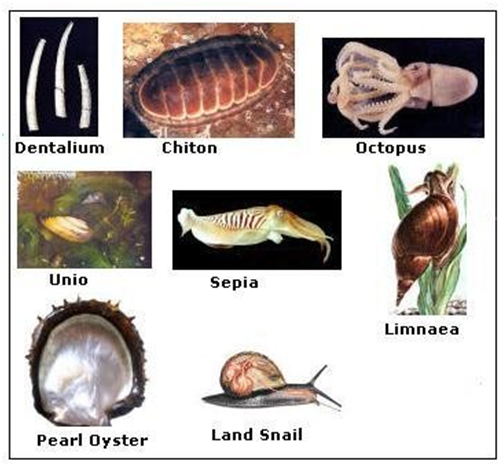
Phylum Mollusca
• Level of Organization – Organ systems, the cells have three layers– called Triploblastic
• Symmetry – Bilaterally symmetrical
• Segmentation – Little segmentation
• Body Cavity/ Coelom – Reduced
• Presence of Organs – Definite organs
• Examples – Snails
• Other Characteristics
o Body is divided into head, Visceral Mass and Muscular Foot.
o Some of the molluscs have hard external shell like that of Snails and some have internal reduced shell like that in Octopus.
o They have an open circulatory system
o There is a kidney-like organ for excretion

 Science Made Easy
Science Made Easy

